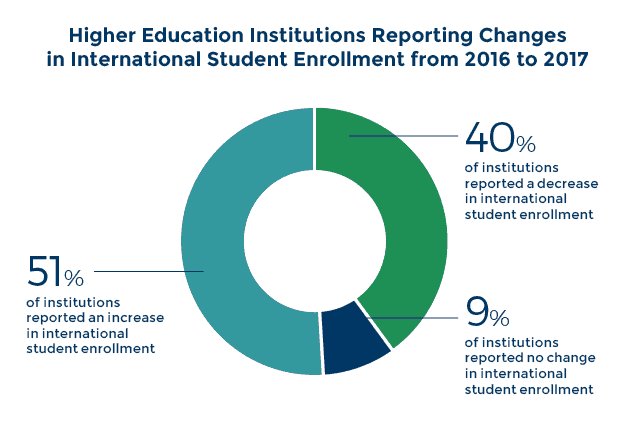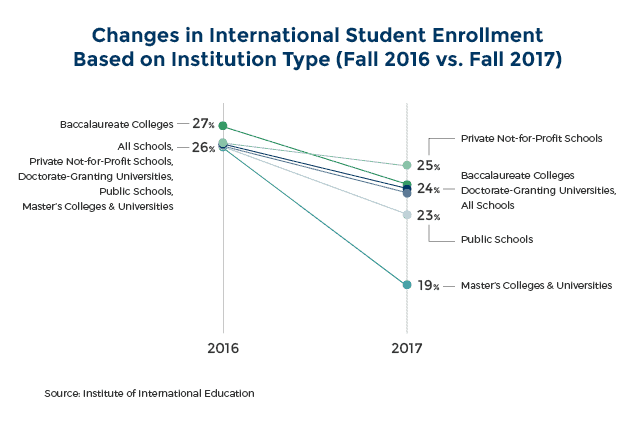International Students in the United States: Fall 2017 Enrollment Trends
Friday | October 6, 2017 | by Kelly Acheson

The International Institute of Education (IIE) has published its latest report on the expectations for international student enrollment at U.S. higher education institutions for fall 201
7.
How is the United States’ shifting political climate affecting enrollment at colleges and universities? And has international student enrollment at U.S. universities been impacted by President Donald Trump’s new immigration policies and recent travel ban?
The Report’s Findings
Below are some of the key findings from this report on the trends in international student enrollment at U.S. higher education institutions:
International students’ interest in studying in the U.S. has remained steady
This is likely because U.S. higher education institutions have stepped up their marketing efforts to attract international students and encourage them to apply. Additionally, U.S. colleges and universities are committed to fostering international diversity in their student bodies and have continued to welcome international students with open arms.
As IIE President Allan Goodman stated, “The intellectual contributions and diverse cultural perspectives that international students bring to U.S. campuses are extremely valuable. Educators are letting students know they are welcome here and working to prepare them for a successful academic experience in the United States.”
“Educators are letting students know they are welcome here.”
Even though higher education institutions have advocated for and welcomed international students, the U.S. travel ban has left some international students confused and worried about entering the country. The current U.S. travel ban affects eight countries. Although most students from these countries who have been accepted into U.S. universities are exempt from the ban, this latest order restricts all travel from North Korea and Syria. That being said, the political climate has not impacted international students who wish to come to the U.S. to the same extent as other immigrant populations looking to enter the country.
Because U.S. higher education institutions are actively fighting the travel ban in court and, at the same time, encouraging international students to continue to apply to U.S. schools, international students’ interest has remained strong despite fears of a significant decrease in applications.
International student enrollment at U.S. higher education institutions has varied depending on the type of institution
This finding is best explained by the fact that some higher education institutions reported small increases in the number of international students enrolled this year, which offset the slight decreases reported by other institutions.
The U.S. has a broad range of higher education institutions, which include private non-for-profit colleges, public universities, doctoral-granting institutions, and master’s colleges and universities, among others, and each of these institutions and study programs has seen different international student enrollment trends.
The infographic below shows how different institutions reported either increases, decreases, or no change in international student enrollment:
Both international undergraduate and graduate student enrollment has decreased from fall 2016 to fall 2017
Overall the report found that international undergraduate enrollment decreased from 26 to 24 percent from fall 2016 to fall 2017. Domestic undergraduate student enrollment also decreased by two percentage points during this same period, so the drop in international undergraduate enrollment is not that significant. However, international graduate student enrollment has fallen more sharply, with graduate deans at 46 percent of responding institutions reporting steep declines in international student enrollment.
Although these statistics paint a mixed picture of international student enrollment, it’s important to note that, despite the political climate, U.S. universities and colleges are continuing to advocate for international students by emphasizing their contributions to the higher education community.
WES’ Commitment to International Students
At WES, we stand firmly by our commitment to helping international students achieve their educational goals in the U.S. and Canada. If you’re an international student interested in studying in the U.S., apply for a credential evaluation today to find out how your academic accomplishments compare to the U.S. academic standards.


